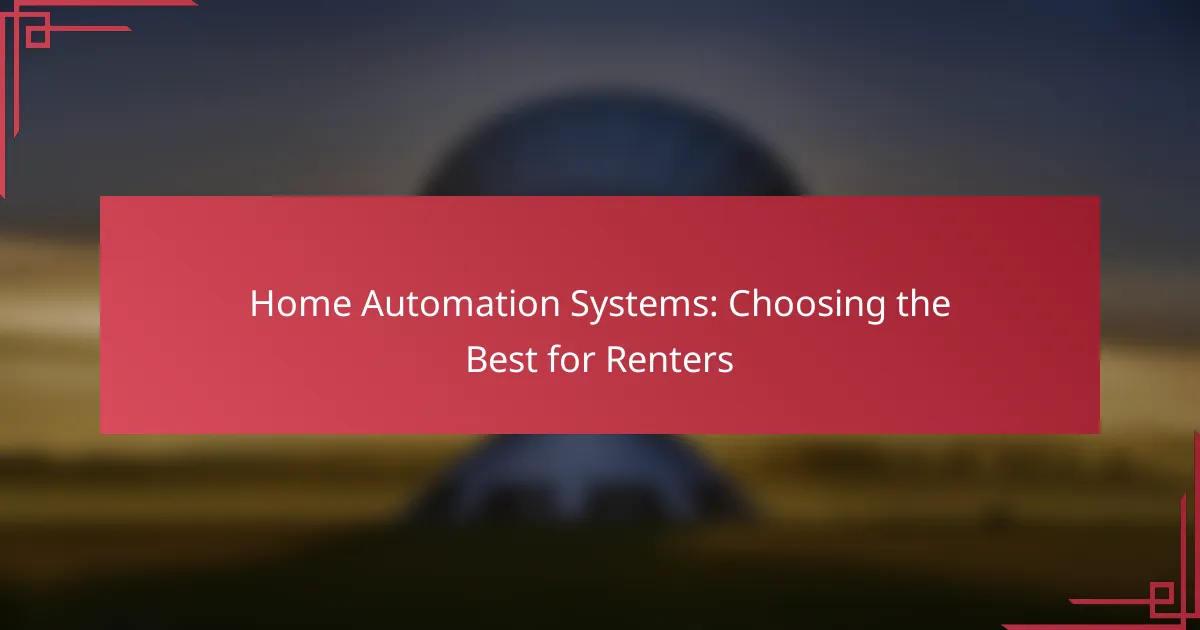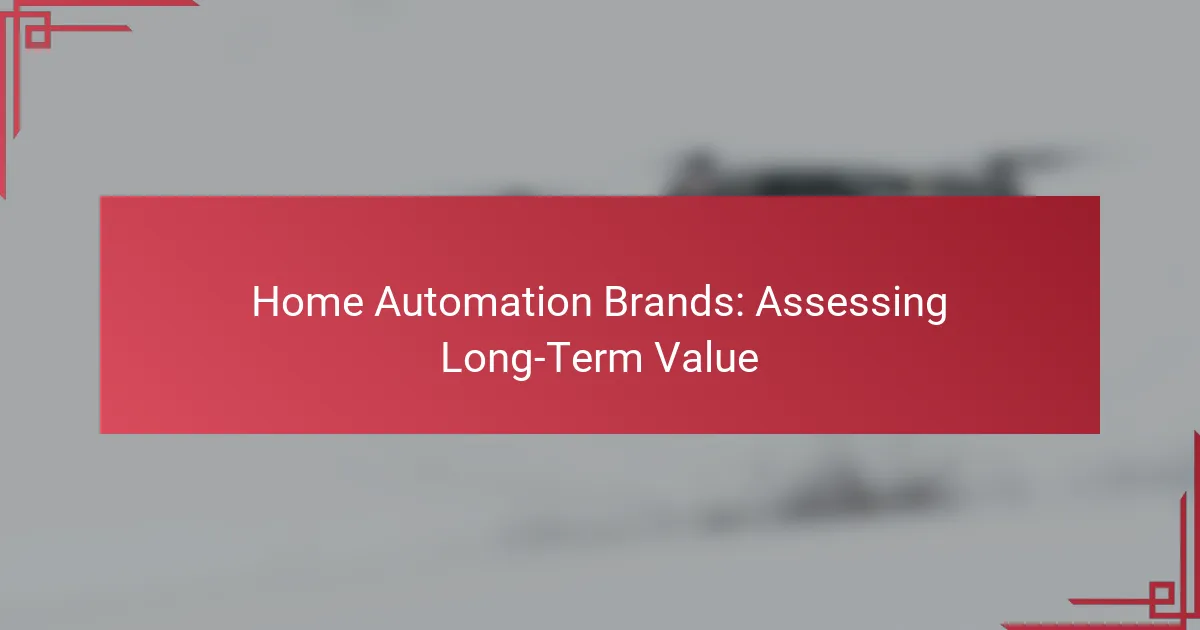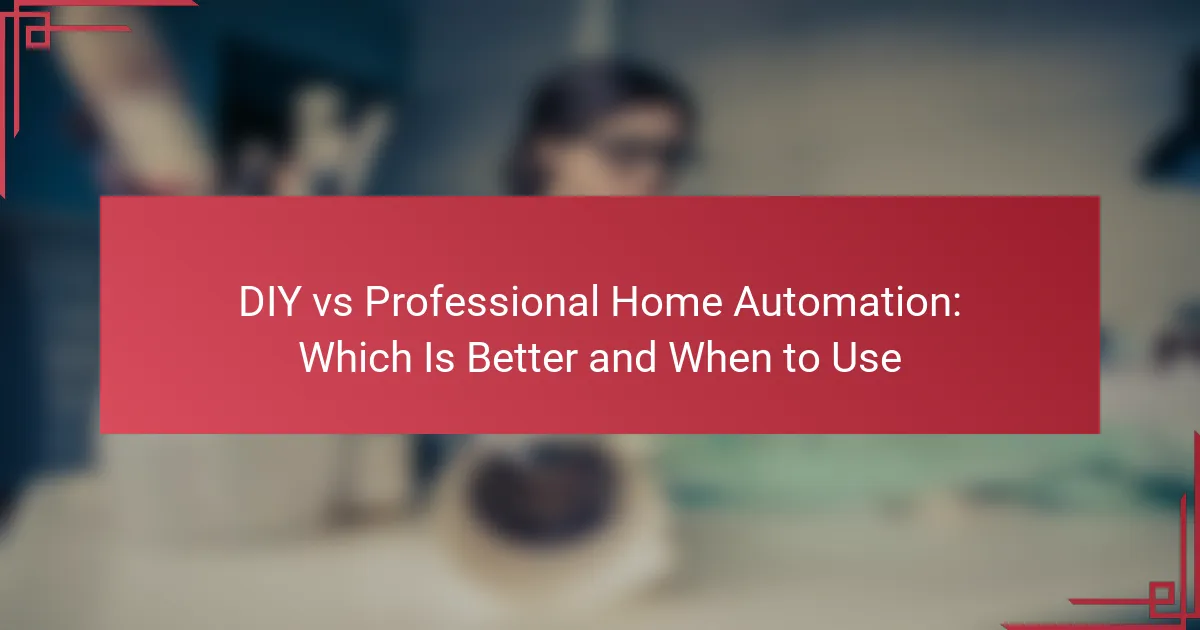For renters looking to enhance their living spaces, choosing the right home automation system is essential. The ideal systems are easy to install, portable, and do not require permanent changes to the property, allowing for convenience and security without breaching rental agreements. By prioritizing compatibility, ease of installation, and cost, renters can enjoy the benefits of smart technology while maintaining their lease terms.
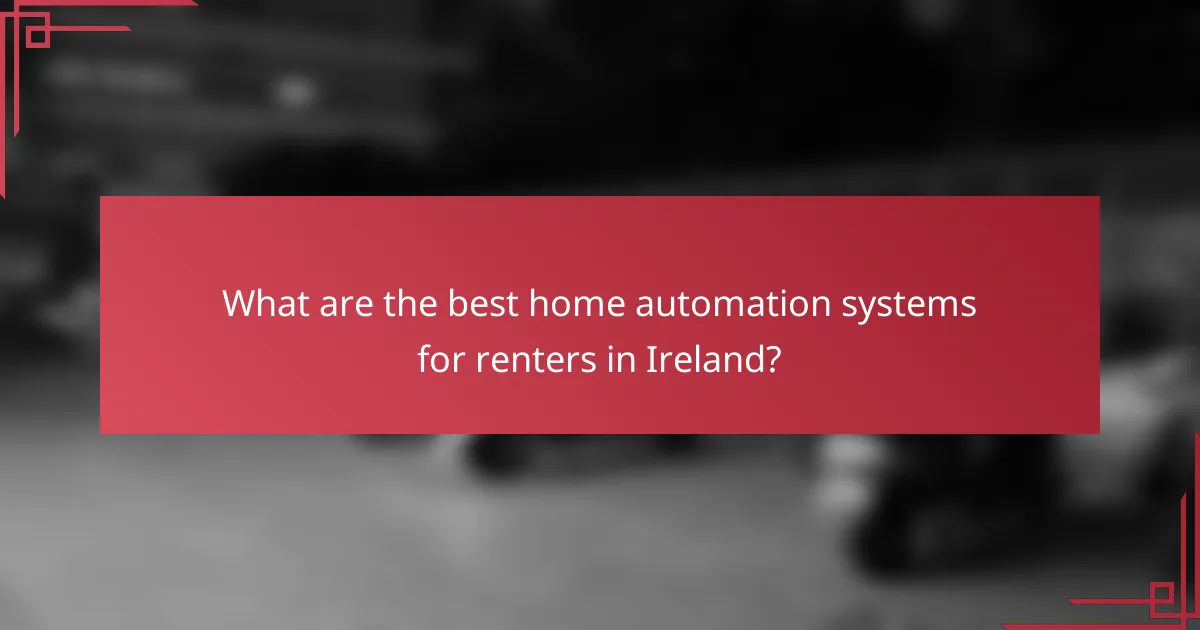
What are the best home automation systems for renters in Ireland?
The best home automation systems for renters in Ireland are those that are easy to install, portable, and do not require permanent modifications to the property. Systems like smart lighting, voice assistants, smart locks, and hubs provide flexibility and convenience without violating rental agreements.
Philips Hue Smart Lighting
Philips Hue Smart Lighting offers a versatile solution for renters looking to enhance their home ambiance. These smart bulbs can be easily installed in existing light fixtures and controlled via a smartphone app or voice commands.
Consider starting with a starter kit that includes a bridge and a few bulbs, which allows for easy expansion later. The ability to customize colors and set schedules can significantly improve the atmosphere of your living space.
Amazon Echo Dot
The Amazon Echo Dot serves as a compact smart speaker that integrates with various home automation systems. It allows you to control compatible devices using voice commands, making it a convenient option for renters.
With its affordable price point, the Echo Dot can act as a central hub for managing smart devices, playing music, and providing information. Ensure that your other devices are compatible with Alexa for seamless integration.
August Smart Lock
The August Smart Lock is an ideal choice for renters who want to enhance their home security without altering the existing door hardware. This smart lock fits over your current deadbolt, allowing for keyless entry and remote access.
Installation is straightforward and can be completed in minutes. You can grant temporary access to guests and monitor who enters and exits your home, all through a user-friendly app.
Google Nest Hub
The Google Nest Hub acts as a central control panel for your smart home devices, providing a visual interface to manage everything from lighting to security. Its compact design makes it suitable for any room in a rental property.
With voice control and a touchscreen, it allows for easy interaction with various smart devices. Consider using it to display calendars, photos, or even recipes, making it a multifunctional addition to your home automation setup.
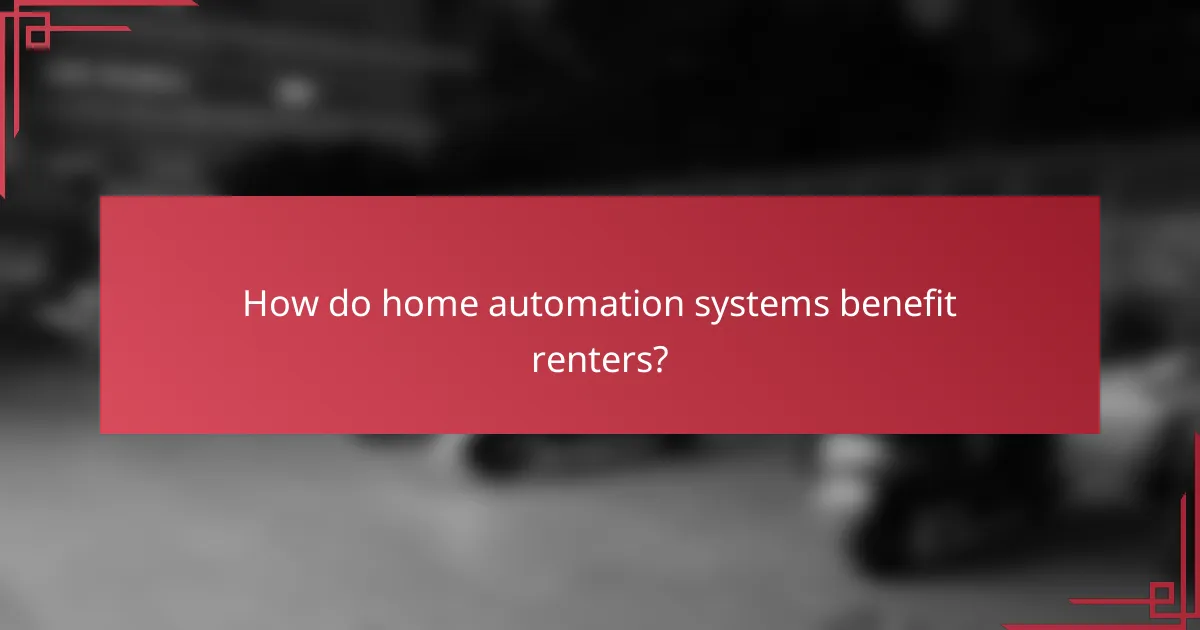
How do home automation systems benefit renters?
Home automation systems offer renters enhanced convenience, security, and energy efficiency without the need for extensive renovations. These systems allow for easy control of various devices, making everyday living more manageable and cost-effective.
Enhanced security features
Home automation systems can significantly improve security for renters by integrating smart locks, cameras, and alarm systems. These features allow renters to monitor their homes remotely and receive alerts about unusual activity.
For example, smart locks enable keyless entry, reducing the risk of lost keys or unauthorized access. Many systems also offer video doorbells, allowing renters to see who is at their door from their smartphones.
Energy efficiency improvements
Renters can benefit from energy-efficient home automation systems that help reduce utility bills. Smart thermostats and lighting systems can adjust settings based on occupancy and time of day, leading to lower energy consumption.
For instance, a smart thermostat can learn your schedule and optimize heating and cooling, potentially saving renters up to 10-15% on their energy bills. Additionally, smart plugs can turn off devices automatically when not in use, further enhancing energy savings.
Convenience and control
Home automation systems provide renters with greater control over their living environment, allowing them to manage devices from anywhere using a smartphone app. This convenience can streamline daily routines and improve overall comfort.
For example, renters can set schedules for lights to turn on and off, adjust the thermostat remotely, or even control appliances like coffee makers and vacuum cleaners. This level of control not only enhances comfort but also adds a layer of flexibility to renters’ lifestyles.

What should renters consider when choosing a home automation system?
Renters should prioritize compatibility, ease of installation, and cost when selecting a home automation system. These factors ensure that the system integrates well with existing setups, is simple to set up without permanent modifications, and fits within budget constraints.
Compatibility with existing devices
When choosing a home automation system, check its compatibility with your current devices. Many systems work with popular smart home brands like Philips Hue, Nest, or Amazon Echo, allowing seamless integration.
Ensure the system supports the communication protocols used by your devices, such as Wi-Fi, Zigbee, or Z-Wave. This will prevent issues with connectivity and functionality.
Ease of installation
For renters, ease of installation is crucial since many may not want to make permanent changes to their living space. Look for systems that offer a plug-and-play setup, which typically requires minimal tools and time.
Consider systems that provide detailed instructions or mobile apps to guide you through the installation process. Avoid complex setups that may require professional installation or extensive wiring.
Cost and subscription fees
The cost of home automation systems can vary widely, with basic setups starting in the low hundreds of USD. Additionally, some systems may require ongoing subscription fees for premium features or cloud services.
Evaluate your budget and consider both initial costs and potential long-term expenses. Look for systems that offer a good balance of features without excessive fees, and check for any hidden costs associated with device compatibility or additional services.
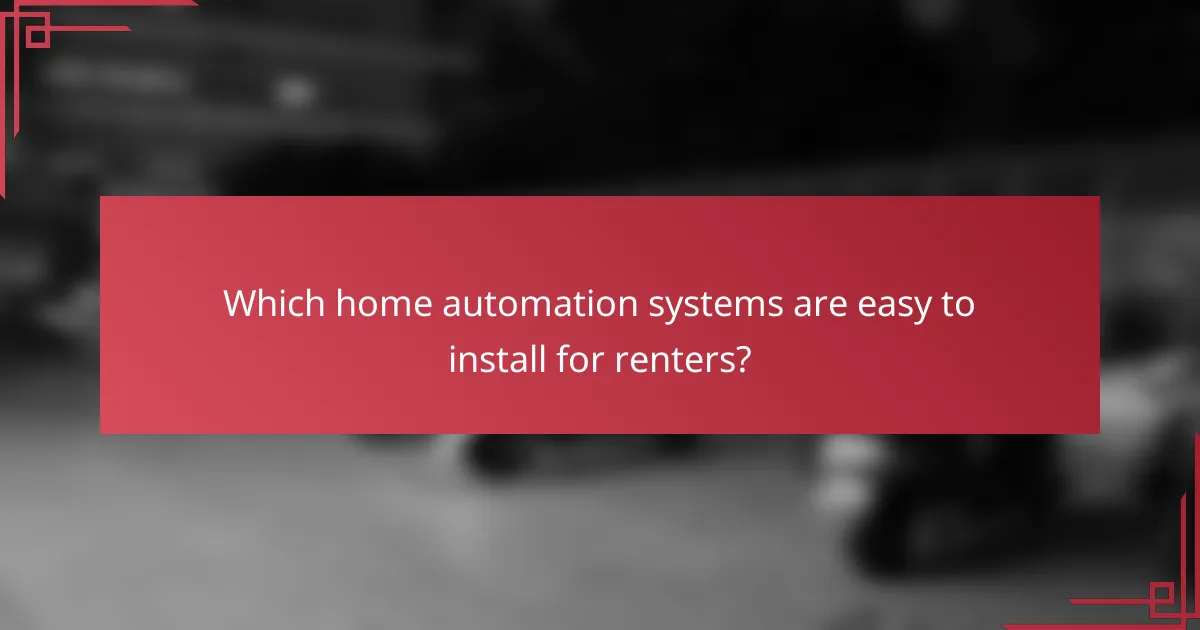
Which home automation systems are easy to install for renters?
Home automation systems that are easy to install for renters typically require no permanent modifications and can be set up quickly. Options like smart plugs and video doorbells are ideal as they offer convenience without the need for complex installation processes.
TP-Link Kasa Smart Plugs
TP-Link Kasa Smart Plugs are a popular choice for renters due to their simple plug-and-play design. These devices connect to your Wi-Fi network, allowing you to control any plugged-in appliance through a smartphone app.
Installation is straightforward: just plug the device into an outlet, connect it to your Wi-Fi, and download the Kasa app. This process usually takes just a few minutes. Smart plugs can help you manage energy consumption by scheduling devices to turn on or off at specific times.
Consider the compatibility with your existing smart home ecosystem, as Kasa plugs work well with Amazon Alexa and Google Assistant. Avoid overloading the plugs to prevent damage and ensure safety.
Ring Video Doorbell
The Ring Video Doorbell is an excellent option for renters looking to enhance home security without permanent installation. This device replaces your existing doorbell and connects to Wi-Fi, allowing you to see and communicate with visitors via a smartphone app.
Installation typically involves removing the old doorbell and connecting the Ring device to existing wiring or using a battery-powered option. The entire process can take under an hour. Ensure your Wi-Fi signal is strong at the door location for optimal performance.
Keep in mind that while the Ring offers features like motion detection and cloud video storage, subscription fees may apply for certain functionalities. Check local regulations regarding video recording in public spaces to ensure compliance.

What are the top features to look for in a home automation system?
When selecting a home automation system, prioritize features that enhance convenience, security, and energy efficiency. Key aspects to consider include voice control capabilities and mobile app integration, which can significantly improve user experience and system functionality.
Voice control capabilities
Voice control allows users to operate their home automation systems hands-free, making it a vital feature. Look for systems compatible with popular voice assistants like Amazon Alexa, Google Assistant, or Apple Siri, as these can offer seamless integration and a wide range of commands.
Consider the responsiveness and accuracy of the voice recognition technology. Systems that support multiple languages or dialects can be beneficial in diverse households. Additionally, check if the system can control various devices, such as lights, thermostats, and security cameras, through voice commands.
Mobile app integration
Mobile app integration is essential for managing your home automation system remotely. A user-friendly app should allow you to control devices, monitor security feeds, and receive alerts from anywhere, enhancing convenience and peace of mind.
Evaluate the app’s compatibility with your smartphone’s operating system, whether iOS or Android. Look for features like customizable notifications, scheduling options, and the ability to create automation routines. A well-designed app can significantly enhance your overall experience and control over your home environment.
